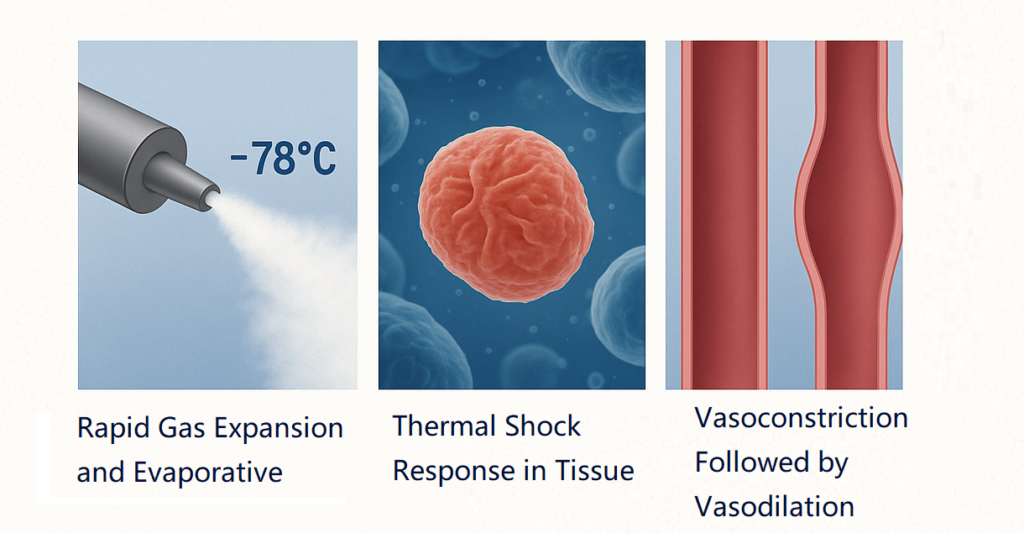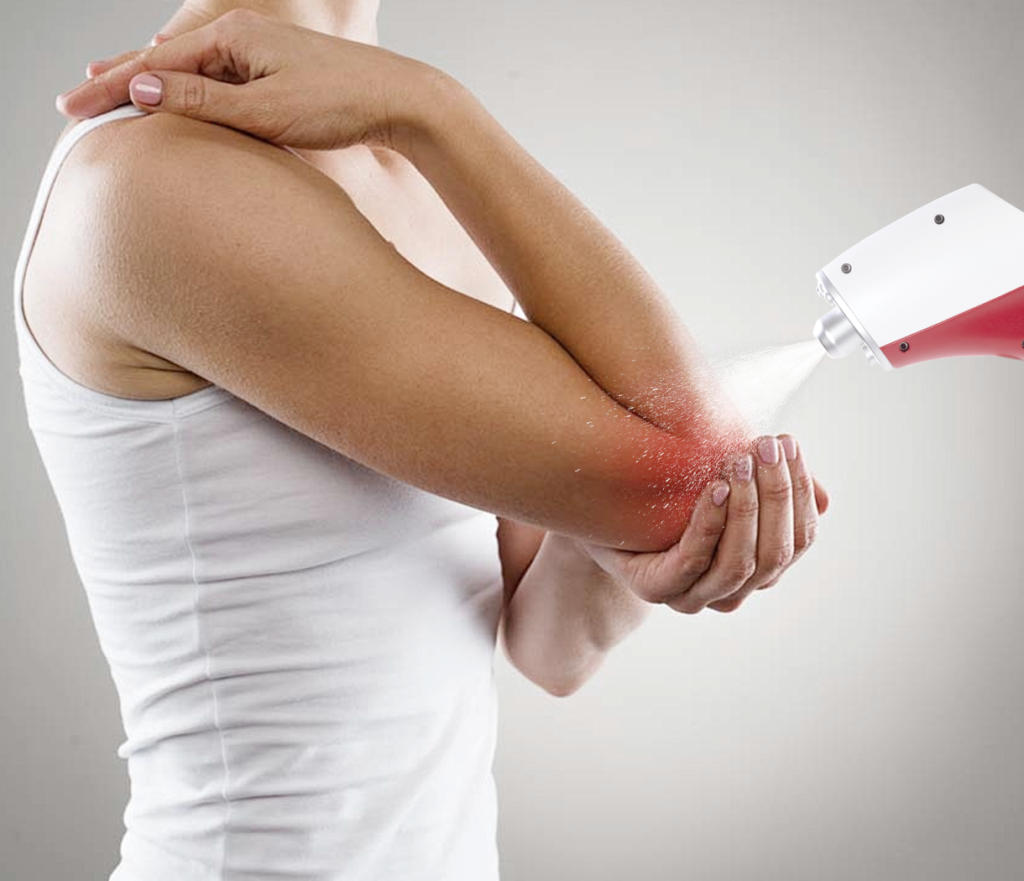Introduction
Cryotherapy has become a go-to solution in modern healthcare, valued for its effectiveness in pain relief and recovery. Among its forms, CO₂ cryotherapy stands out due to its portability, efficiency, and safety. It’s especially useful in settings that require quick, reliable interventions—rehab clinics, sports fields, veterinary care, or emergency medicine. This article explores how CO₂ cryotherapy works, why it’s effective, and where it shines. By examining its physiological mechanisms, clinical benefits, and practical design, we show how this technology brings high-impact therapy to diverse environments with minimal setup and maximum results.
Understanding Mechanism of CO₂ Cryotherapy
The therapeutic efficacy of CO₂ cryotherapy stems from a complex interplay of physiological responses triggered by controlled application of extreme cold temperatures. To fully appreciate the clinical benefits of this modality, it is essential to understand the fundamental mechanisms that govern tissue response to cryotherapeutic intervention. The following sections explore the intricate biological processes that make CO₂ cryotherapy such an effective therapeutic tool.

Rapid Gas Expansion and Evaporative Cooling
CO₂ cryotherapy works through rapid gas expansion. When liquid CO₂ is released, it instantly becomes gas, creating intense cold—up to -78°C—within seconds. This process, known as the Joule-Thomson effect, allows for immediate cooling without external refrigeration. Treatments last just 10–15 seconds per site, delivering precise cold exposure that’s strong enough to trigger healing responses but short enough to avoid tissue damage. This fast, controlled cooling is ideal for clinical and emergency use, offering consistent therapeutic results with minimal preparation or complexity.
Thermal Shock Response in Tissue
The sudden cold from CO₂ cryotherapy triggers a thermal shock response in tissues, activating protective cold shock proteins. These proteins stabilize cells and reduce metabolic activity, easing inflammation and promoting recovery. Brief exposure—10–15 seconds—creates a beneficial stress that strengthens tissue resilience. This hormetic effect boosts the body’s natural repair systems without harming healthy cells. By carefully balancing duration and intensity, CO₂ cryotherapy activates healing without overstressing tissue, making it a safe and powerful tool for recovery.
Vasoconstriction Followed by Vasodilation
CO₂ cryotherapy causes a two-phase blood vessel reaction. First, vasoconstriction reduces blood flow, inflammation, and swelling. Then, as tissues rewarm, vasodilation increases circulation, delivering oxygen and nutrients while clearing waste. This process supports healing and reduces pain. The short cold burst is enough to stimulate these changes without damaging tissue. The prolonged vasodilation phase keeps therapeutic benefits going after the session ends, making this treatment useful for acute injuries, swelling, and chronic inflammation.
Modulation of Nerve Conduction
Cold from CO₂ cryotherapy slows nerve conduction, especially in small pain fibers. This reduces pain signals reaching the brain and provides immediate relief. The effect lasts even after treatment. Larger motor nerves are less affected, so function is preserved. Additionally, intense cold stimulates mechanoreceptors that interfere with pain transmission at the spinal level—a concept known as gate control. Together, these effects make CO₂ cryotherapy a precise and effective analgesic tool without impairing mobility.
Inflammatory Cascade Regulation
CO₂ cryotherapy reduces inflammation at multiple levels. It slows the enzymes that produce inflammatory mediators like prostaglandins and cytokines. Cold also limits the flow of inflammatory cells by narrowing blood vessels, then flushes out debris during vasodilation. Membrane stability improves, and complement activation is reduced. These effects make it ideal for treating acute injuries, post-surgery swelling, and chronic joint inflammation—cutting down pain and speeding up recovery.
Selective Tissue Preservation
Unlike extreme cryo methods that damage tissue, CO₂ cryotherapy carefully balances cold intensity and exposure time. Its -78°C burst for 10–15 seconds targets inflammation and promotes healing while sparing healthy tissue. Inflammatory and damaged cells are more sensitive to cold, allowing for selective therapeutic action. This precision makes it safe for use on delicate or critical areas, offering effective treatment without risking tissue loss or function.
Multi-Location Deployment: Where It Works Best
The versatility of CO₂ cryotherapy systems extends far beyond traditional clinical settings, making them invaluable tools across diverse healthcare and performance environments. The following sections explore the specific applications and benefits of CO₂ cryotherapy in various professional settings, highlighting how this technology adapts to meet unique challenges and requirements in each environment.

Use in Physical Therapy and Rehabilitation Clinics
Physical therapy clinics benefit greatly from CO₂ cryotherapy’s ability to manage acute injuries, post-surgical recovery, and chronic pain. Its immediate analgesic and anti-inflammatory effects help control swelling, enabling early mobilization. For sensitive post-op tissues, the precise temperature control avoids complications seen with ice. In chronic cases, therapists can integrate CO₂ cryotherapy into sessions, treating flare-ups in real-time to maintain progress. Its portability supports use during exercises, while consistent application enhances outcomes. Educationally, it reinforces professional standards, demonstrating advanced care to staff and patients, boosting trust and treatment compliance.
Sports Injury Management in Field Settings
In athletic settings, CO₂ cryotherapy delivers instant pain relief and swelling control right on the field or in locker rooms. Unlike ice packs, which need preparation and may underperform, CO₂ units provide -78°C treatment instantly. This immediate application is crucial in early injury management. Portable and travel-ready, these systems support consistent athlete care across events. With user-friendly controls and safety features, they’re accessible to all levels of sports medicine staff. The reliability ensures effective care regardless of environment—whether during games, training, or on the road.
Emergency Use: Ambulance and First Responders
Emergency teams need fast, effective pain relief in unpredictable environments. CO₂ cryotherapy systems meet that need with immediate, controlled cold therapy for burns, trauma, and musculoskeletal injuries. They’re safer and more effective than ice in unstable settings, minimizing risks of cold injury or overcooling. Compact and power-free, these systems are ready for immediate use during transport, improving patient comfort and stabilizing inflammation early. Their professional design reassures patients and supports responder credibility. For EMTs and paramedics, these tools enhance field care without adding logistical burdens.
Veterinary and Equine Clinics
CO₂ cryotherapy is ideal for animal care, where quick, controlled treatments are essential. In horses, it eases pain from injuries or chronic lameness with brief, low-stress sessions—perfect for sensitive animals. For small pets, it reduces inflammation and discomfort in delicate areas post-surgery or after trauma. Its safe, targeted delivery avoids complications and stress. Portable design allows vets to treat animals on-site at farms or stables without sacrificing care quality. The medical-grade look and precise performance also reassure pet owners, showcasing the clinic’s advanced care capabilities.
Remote Clinics and Mobile Health Units
CO₂ cryotherapy offers reliable, portable care for underserved or remote areas. It works without power or setup, making it a perfect solution where infrastructure is limited. Clinics can use it for acute pain, injury management, and inflammation control without needing complex equipment. For mobile health units, the system ensures consistent therapy across various sites. Easy operation and safety features enable quick staff training, expanding treatment capacity in low-resource settings. By offering professional-grade therapy in portable form, it raises care standards in places with limited access to advanced medical tools.
Multi-Application Benefits: What It Treats
The therapeutic versatility of CO₂ cryotherapy extends across numerous medical and rehabilitation applications, making it a valuable tool for treating diverse conditions affecting various body systems. The following sections explore the specific applications and benefits of CO₂ cryotherapy across different clinical scenarios, highlighting the mechanisms and outcomes that make this modality effective for each application.
Cryotherapy for Muscle and Joint Pain
CO₂ cryotherapy effectively treats musculoskeletal pain by addressing both symptoms and root causes. For acute muscle injuries like strains or sprains, the -78°C cold provides fast pain relief by slowing nerve conduction and controlling inflammation. A 10–15 second treatment reduces pain signals and limits tissue damage. Chronic joint conditions such as osteoarthritis benefit from repeated treatments, which ease swelling and stiffness while improving mobility and quality of life. Unlike ice packs, CO₂ cryotherapy offers consistent, controlled application without harming tissues. Its biphasic vascular effects also improve blood flow, aiding tissue healing. This dual-action therapy—fast symptom relief and long-term recovery—makes CO₂ cryotherapy a smart choice for managing complex muscle and joint pain.
Post-Operative Inflammation and Pain Relief
Post-surgery pain and swelling can delay recovery. CO₂ cryotherapy helps by reducing excessive inflammation while preserving natural healing processes. The extreme cold numbs pain instantly and calms overactive immune responses, improving comfort without relying solely on medication. Its precision delivery makes it ideal for treating sensitive post-operative areas without risk of tissue injury. With just 10–15 seconds per application, it supports pain control during rehab exercises or movement. Patients experience less reliance on opioids, better mobility, and faster recovery timelines. CO₂ cryotherapy combines safety, precision, and effectiveness, making it an ideal addition to any post-surgical care plan.
Neurological Applications
CO₂ cryotherapy has advanced uses in nerve-related pain conditions like diabetic neuropathy or carpal tunnel syndrome. The intense cold temporarily blocks abnormal nerve signals and reduces inflammation in surrounding tissues. It also improves circulation, helping nerves heal. For nerve compression conditions, cryotherapy relieves pressure and modulates pain pathways. Trigger points, often caused by muscle spasms, respond well to the cold, which helps release tension and reset neuromuscular patterns. The brief, targeted application allows safe, localized treatment without affecting nearby healthy tissue. By combining nerve modulation with anti-inflammatory effects, CO₂ cryotherapy offers a non-invasive solution for complex neurological pain.
Veterinary Rehabilitation
CO₂ cryotherapy is highly effective in animal rehab, offering pain relief and inflammation control with precision and safety. In dogs, it’s used for post-op recovery, arthritis, and injury care, reducing pain and stress with short, targeted sessions. This is especially helpful for anxious or aggressive animals. Horses benefit from treatment of tendon, ligament, and lameness issues with precise application that avoids damage to nearby tissue—vital for performance animals. In exotic animals, CO₂ cryotherapy offers a safe alternative when traditional methods may not be suitable. Its adaptability, professional-grade design, and fast results make it a valuable tool in veterinary care.

Portability and Practical Advantages
The practical advantages of CO₂ cryotherapy systems extend far beyond their therapeutic capabilities, encompassing design features and operational characteristics that make them ideally suited for diverse clinical and field applications. These practical benefits often determine the success or failure of therapeutic programs, making them critical considerations for healthcare providers evaluating cryotherapy options.
Portable CO₂ Cryotherapy System for Remote Access
Portable CO₂ cryotherapy systems offer advanced therapeutic power in a compact, mobile form, enabling effective treatment in remote or infrastructure-limited settings. Lightweight and easy to transport, these units function without external power, water, or compressed air, making them ideal for field medicine, sports events, and mobile clinics. Built for durability, they withstand harsh conditions with features like shock resistance and weatherproof materials. Storage is simplified through integrated carrying cases and accessory compartments. With quick setup and immediate usability, these systems support fast deployment in emergencies or time-sensitive care scenarios. Their portability doesn’t compromise performance, making them a reliable solution for healthcare providers needing flexibility, durability, and therapeutic quality in unpredictable environments.
Treatment Speed, Precision and Safety in CO₂ Cryo Units
CO₂ cryotherapy units offer unmatched treatment speed, precision, and safety, making them ideal for fast-paced clinical settings. They deliver -78°C temperatures instantly, eliminating prep time and allowing immediate use for acute injuries and emergencies. Precision controls let clinicians adjust flow rate, timing, and applicator tips for targeted, condition-specific treatment. Built-in safety features—like automatic shutoffs, pressure relief systems, and real-time temperature monitoring—protect both patient and operator. Ergonomic designs reduce fatigue, while consistent performance ensures repeatable outcomes across sessions and providers. Unlike ice or gel packs, CO₂ systems maintain exact parameters, enabling standardized protocols and improving treatment reliability in both routine and advanced care environments.
Real-World Success Stories Across Sectors
CO₂ cryotherapy systems have delivered tangible benefits across diverse sectors. A major league baseball team integrated the systems into their training facilities and medical kits, resulting in a 35% reduction in time lost to minor injuries over two seasons. Emergency services in rural areas used portable CO₂ units during transport to manage burns and trauma pain, improving patient comfort and reducing complications. In veterinary medicine, a canine rehabilitation clinic employed CO₂ therapy for precision cooling, reporting faster recovery and better compliance in performance dogs. Humanitarian organizations relied on these systems during disaster responses, where their portability and independence from infrastructure helped deliver fast pain relief in critical conditions. A multi-location physical therapy practice used CO₂ units to unify treatment protocols, boosting clinical consistency, therapist confidence, and patient outcomes. These success stories underscore the flexibility, reliability, and real-world effectiveness of CO₂ cryotherapy across medical, emergency, veterinary, and rehabilitation settings.
Conclusion: One System, Many Locations and Needs
CO₂ cryotherapy systems bridge cutting-edge technology with real-world healthcare needs. Their physiological effects—pain relief, inflammation control, and improved circulation—are delivered with precision, ensuring consistent and safe treatment. The systems excel in diverse settings, from clinics to disaster zones, offering immediate, portable, and effective care without reliance on external infrastructure. Their compact design and reliability make them essential for modern providers seeking consistent performance and improved patient outcomes across multiple locations. By enabling standardized treatment, reducing preparation time, and improving operational efficiency, CO₂ cryotherapy supports high-quality care regardless of location. As healthcare increasingly moves beyond fixed facilities, demand for safe, mobile solutions will rise. With proven therapeutic benefits and flexible application, CO₂ cryotherapy systems are well-positioned to become indispensable tools in future-ready healthcare delivery—empowering professionals to meet patient needs wherever they arise.
Common Questions about CO₂ Cryotherapy in Multi-Location Settings
Yes. Modern CO₂ systems are built for safety and mobility. With built-in safety features like automatic shutoffs and pressure controls, they’re designed for use in field settings, mobile clinics, or even during patient transport without compromising safety.
CO₂ cryotherapy is effective for managing acute injuries (sprains, strains, contusions), chronic pain, inflammation, burns, and post-op recovery. Its versatility makes it useful in sports, emergency, veterinary, and physical therapy settings.
No. Most portable CO₂ cryotherapy systems are self-contained and do not require electricity, water, or compressed air. They’re designed to work independently, even in remote or disaster-struck areas.
Setup is quick—typically under 5 minutes. Once activated, the system reaches therapeutic temperatures immediately, allowing rapid treatment without delay.
Absolutely. Because CO₂ systems deliver consistent temperature and flow, clinics can develop standardized protocols to ensure uniform care quality across multiple sites and providers.
Minimal training is needed. Most systems are intuitive, with user-friendly controls. Quick-start guides and short in-service sessions usually suffice for safe and effective use across locations.



